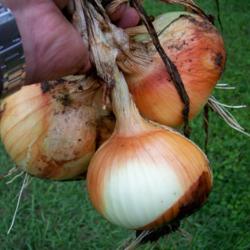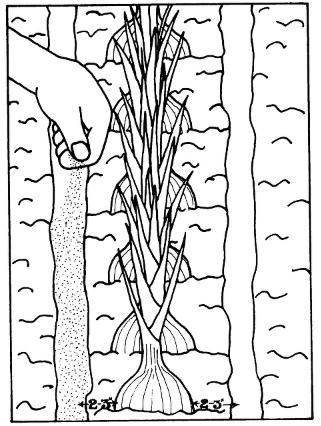
Onions will grow in practically any kind of soil but, one that's rich in decayed organic matter and humus and drains well is best. Heavy soils that stick together after rain will bake hard when the sun comes out, making it difficult for the bulbs to expand. Another problem with heavy soils is that water stays on the surface in puddles. That can drown plants! Southern gardeners can overcame this problem by making raised planting beds that are about 10 inches wide and four to six inches high. When it's time to plant onion sets in January, your raised seedbeds won't be too wet to plant. The planting beds drain well and leave the soil moist but not packed, soggy or impossible to work.
Adding Organic MatterAdding plenty of organic matter to heavy soil will help to loosen it up and improve drainage. With light, sandy soil, the organic matter will help hold the water after rain or irrigation. If your soil has plenty of organic matter -- such as decayed leaves or compost -- worked into it, it will stay moist after a rain or irrigation. Organic matter acts like a sponge, holding moisture near the surface. That's good for onions, which have shallow roots and can't tap water or nutrients deep in the soil.
If you're wondering about soil acidity or alkalinity (pH), onions do best if the soil pH is between 5.5 and 6.5, a little on the acid side. They'll grow outside this range, but not quite as well. You can easily test your soil's pH by using a soil-testing kit, available at garden centers. Soil testing is also done by county cooperative extension agents.
Fertilizer
Onions love fertilizer and they can take about twice as much as most other vegetables. Your onions won't mind it a bit if you add plenty of well-rotted or dried manure, compost or commercial fertilizer to the soil before planting. In addition, try adding a handful of bonemeal or rock phosphate, which is high in phosphorus, when you prepare your soil for planting. Phosphorus stimulates early bulb formation and root growth. It helps give onions a rapid start.
To determine how much fertilizer you should mix in your onion row before planting, this chart may help.
Onion Row/ 5-10-10/ 8-16-16/ 10-10-10
10'long x 15"wide/ 2 1/4 cups/ 1 cup/ 1/2 cup
25'long x 15"wide/ 6 1/4 cups/ 2 cups/ 11/4 cups
50'long x 15"wide/ 12 1/2 cups/ 4 cups/ 2 1/4 cups
100'long x 15"wide/ 25 cups/ 8 1/3 cups/ 5 cups
Consider this a minimum requirement. Also add a 1- to 2-inch layer of yearly compost or dried manure for great onion growth.
Side-DressingWhile your onions are growing you'll want to side-dress them. A side-dressing is simply an extra ration of nutrients; it can be additional compost, dried manure or commercial fertilizer. Onions like a steady supply of nutrients all season long, but they need a little more fertilizer once the bulbs start forming than they do at the beginning. That's because they use a lot of energy making bulbs.
The best time to apply a side-dressing is when the bulbs begin to swell. A pound and a half of 5-10-10 fertilizer or a few shovelfuls of composted manure will nourish a 15-inch-wide, 20-foot-long row; if your onions are in a narrow, straight-line row, this amount will be good for a row 100 feet long.
There are a couple of easy ways to apply a side-dressing. If you plant a single row, you can make a shallow furrow down both sides of the row, two to three inches from the plants and sprinkle the fertilizer in the furrow as you go down the row. Then cover it with soil.
If you plant in wide rows you can sprinkle fertilizer a few inches from the bulbs. If you use commercial fertilizer, be careful not to get any on the top green leaves because it might "burn" them. There's no danger of burning if you sprinkle good compost around the bulbs. In either case, the next rain or watering will start carrying the fertilizer or compost toward the onion roots.
If you have a very sandy, porous soil, your fertilizer will tend to leach straight down instead of spreading out to all the roots. Really sandy soils don't hold water and nutrients very well -- they drain away too fast. You may have to side-dress more often in sandy soil than you would with a clay or loam soil.
 Deficiency Signs
Deficiency SignsHere are the signs that onions need more nutrients:
* Pale yellow or greenish yellow leaves indicate that onions could lack nitrogen. (Leaves can yellow after long, wet periods of weather because a lot of rain washes nitrogen from the soil.)
Before you plant onions, take care of your garden soil. Plants that grow slowly and with many thick-neck bulbs suggest that your onions may lack phosphorus (thick-neck bulbs won't keep as well).
Before you plant onions, take care of your garden soil Onions that develop thick necks, bulbs that are soft with thin skins or tips of leaves that turn brown may signify a lack of potassium.
Important: It's difficult to over-fertilize onions. They require quite a lot of nutrients.
Caution: Don't fertilize onions once the tops start to fall over. Fertilizer isn't needed that late in the season. In fact, the extra boost of energy could cause the onions to sprout new leaves at harvesttime. New growth at the neck of an onion will keep it from completely drying out, and may cause it to rot in storage.
 Victory Seed Company has all the seeds you want for your best garden in 2024.
Victory Seed Company has all the seeds you want for your best garden in 2024.
For 25 years, the family-owned Victory Seed Company has provided the highest quality vegetable, herb and flower seeds to families across the country. We are passionate about providing you the best seeds available that give excellent germination, robust plants, and the harvest you want. With a catalog of over a thousand varieties, we have everything, and our prices are the kinds that we'd want to pay. We have hundreds of yesterday's heirloom vegetables, as well as today's award winning hybrid selections. Get to know us by visiting our website and browsing through our online vegetable seed catalog.
| 1. How Onions Grow |
| 2. Onion Varieties |
| 3. All About Scallions & Chives |
| 4. All About Leeks & Shallots |
| 5. No Room for Alliums? |
| 6. Soil Prep for Alliums ← you're on this article right now |
| 7. Onion Essentials |
| 1. How Onions Grow |
| 2. Onion Varieties |
| 3. All About Scallions & Chives |
| 4. All About Leeks & Shallots |
| 5. No Room for Alliums? |
| 6. Soil Prep for Alliums ← you're on this article right now |
| 7. Onion Essentials |